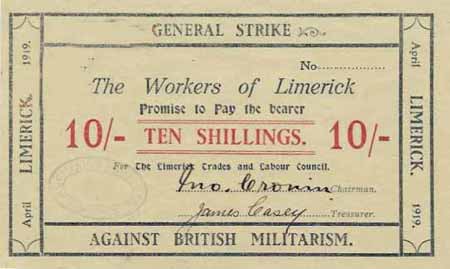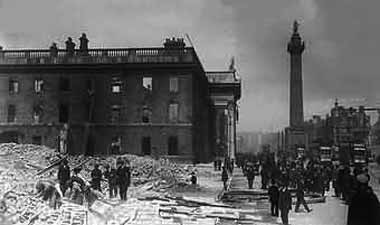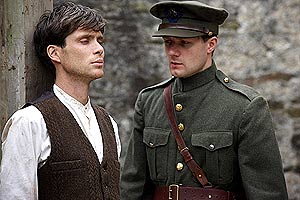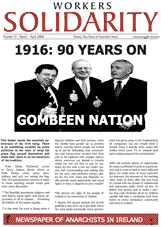
Articles on 1916, the War of Independence and related issues published by the WSM as well as material by other anarchists and documents from the period.
Image: Money issued by the 1919 Limerick Soviet

The insurrection of Easter 1916
The Easter 1916 rising in Dublin is often portrayed simply as nationalist blood sacrifice but it can also be examined as an insurrection which was seriously planned to defeat the British army. It is credited with transforming political attitudes in Ireland, leading to the partally successful war of independance but nationalist histories tend to understate the other reasons why the situation was transformed and to completely ignore the wave of workers struggles that broke out during the war
1916, left republicanism, anarchism and class struggle
This article is an anarchist analysis of the 1916 insurrection and the war of independence in the context of the struggle for socialism in Ireland and internationally. It concentrates on the 'unknown' but intense class struggle that ran alongside the war of independence and the role republicanism played in the suppression of that struggle. It asks 'what is freedom' and shows how anarchism originated amongst earlier European left republicans as an answer to the limitations of republicanism
Connolly, blood sacrifice and defeating British imperialism
Traditionally the anniversary of the rising is marked as being on the Easter Monday rather than the actual date, perhaps in part because of the common theme of blood sacrifice. Histories of the rising tend to focus on the idea of blood sacrifice at both a motivation for the rising and the reason for the creation of the Free State. This article argues that although this may have been an important motivation on the day it was not the reason for the rising nor was the reason for the subsequent rise of the IRA simply found in the execution of the republican leadership after the rising.
1916: What are you celebrating?
Workers Solidarity article published at the time of the 75th anniversary of the Easter Rising
When the Red Flag flew in Munster [In Spanish]
Farm labourers strikes, occupations of creameries, red flags flying and 'soviets' being declared. Not usually the sort of thing associated with the years 1919-1923, the years of the War of Independence and the Civil War. This article covers the events of these years they 'forgot' to tell you about in school.
Notes on The Limerick soviet of 1919 [In Spanish]
The first problem facing the strikers was how to feed Limericks 38,000 inhabitants. The committee sat in secession all of Monday organising food distribution. The committee was divided into two sections, one to relieve food and one to deliver it. Hundreds of special permits were issued allowing shops to open
Syndicalism in Meath & Kildare: The 1919 General local strike
During the 'land campaign' of 1919 agricultural workers, organised through the ITGWU, conducted general action across Ireland in pursuit of improvements in wages
The period around the rising (1886-1923)
Nationalism, socialism and partition
The largest 'Mayday' demonstration in Irish history was in 1919 when what the Belfast Newsletter described as ""a little band of disgruntled Red-Socialists"" led 100,000 workers through the streets of Belfast. Everywhere else in Ireland in 1919 had also seen massive Mayday demonstrations, with 10,000 demonstrating in Burr Co. Offaly. Both North and South a massive wave of working class militancy had grown and although these struggles shared a common rhythm they happened in isolation from each other
The 1907 Belfast strike
In 1907 Belfast saw the first big battle between the working and employing classes in Ireland. The dockers' and carters' strike was the spark which lit a fire of working class militancy. Workers were flexing their muscle, Catholic and Protestant were uniting, 'Larkinism' was giving the bosses nightmares. Even the police got caught up in the new mood and mutinied.
The Emergence Of Modern Irish Socialism (1885-87)
Irish historiography has traditionally been inadequate with regard to working-class political life and this is especially true for late nineteenth-century Ireland. For many historians, the arrival of James Connolly in May 1896 has remained a seminal event, when, in the opinion of F.S.L. Lyons, a spark was lit and Irish socialism began.(1) In fact, organised Irish socialism began in 1885 and is a tradition more diverse and more vibrant than commonly assumed.
The 1913 Dublin Lockout
The formation of the syndicalist ITGWU and the lock out of 1913 that followed it.
Why Ireland is partitioned
The economic basis for the partition of Ireland explained
Audio: Syndicalism in Ireland (1hr, 12mb)
Historian and author of Syndicalism in Ireland Emmet O'Connors talk to the 2nd Dublin Anarchist bookfair 
Review: The Wind That Shakes The Barley
The Wind That Shakes The Barley is a typical Loach movie portraying many of the core techniques of his previous outtings. Again he relies on plunging a shallowly crafted personal relationship, this time between two brothers, into a set of tragic circumstances. These circumstances provide an emotional cover for his overly didactic political approach to popularising alternative historical mythologies that challenge the authors of a victors' history. This time the contested historicity is the rabid nationalism of the Irish text book, that sweeps aside socialist and labour based movements in the process of consolidation of the free state
People
Captain Jack White
Captain Jack White fought in the British army during the Boer war, organised the first workers militia in Ireland during the 1913 lockout and went on to become an anarchist and fight alongside the CNT in Spain
Peadar O'Donnell and the Spanish Revolution
Donal Ó Drisceoil, historian and author of a biography of Peadar O'Donnell, looks at Salud! An Irishman in Spain, a little known account by O'Donnell of his encounter with the revolution in Spain in 1936.
The ideas of James Connolly
James Connolly is probably the single most important figure in the history of the Irish left. He was an organiser in the IWW in the USA but in Ireland is best known for his role in building the syndicalist phase of Irish union movement and for involving the armed defence body of that union, the Irish Citizens' Army in the 1916 nationalist insurrection. This left a legacy claimed at one time or another not only by all the Irish left parties but also by the nationalists of Fianna Fail and Sinn Fein.
Rosie Hackett and the union women of Jacobs Biscuits
On 22 August 1911 three thousand women at Jacob's factory withdrew their labour in pursuit of a pay claim. Jim Larkin said the conditions for the biscuit makers were 'sending them from this earth twenty years before their time'. A contemporary description of the strikers, although not exactly sympathetic to their position, shows clearly how ready workers were to support each other in times of strife.
The rising and modern Ireland

1916: 90 Years on - Gombeen Nation
This Easter marks the ninetieth anniversary of the 1916 rising. There is an unedifying scrabble by every politician in the state to wrap the green flag around themselves and stake their claim to be the inheritors of the tradition. - Front cover story from WS91
Historic texts
The Easter Proclamation
Easter Proclamation, read by Pádraig Pearse outside the GPO, Dublin at the start of the Easter Rising, April 24 1916
The story of the Citizen Army
The playwrite Sean O'Casey was the first secretary of the Irish Citizen Army and in 1914 had drafted its constitution. He wrote this history of the Citizen Army in the period after the 1916 rising. By the time of the rising he had resigned from the ICA in protest at its decision to allow joint membership with the Irish Volunteers. O'Casey played no part in the rising although with other civilian men he was interned in the course of the rising.
Constitution of the Irish Citizen Army
As agreed at a public meeting, held Liberty Hall 22 March 1914 from a draft prepared by Sean O’Casey 
The Only Hope of Ireland - Alexander Berkman
Writing shortly after the execution of James Connolly for his part in the 1916 rising the Russian/US anarchist Alexander Berkman published 'The only hope of Ireland' in his paper 'The Blast'. He argues that British policy towards the leaders of the rising was typical of British policy elsewhere and in particular in India. He also attacks the timidity of Irish American who only organised protest meetings against the executions suggesting that instead "A British Consul ornamenting a lamppost in San Francisco or New York would quickly secure the respectful attention of the British lion". Berkman had been sentenced to 22 years in prison for attempting to assassinate the boss responsible for the massacres of workers during the 1892 Homestead strike. After WWI he was deported from the USA to Soviet Russia. In turn he was deported from there after protesting the Bolsheviks suppression of workers democracy
Workers control and nationalism in Ireland in 1922 Extracts from the British 'Workers Dreadnought' paper on the Soviets formed in Munster that year
Communism vs. reforms, mistakes of the Communist Party of Ireland This critique of the program of the Communist Party Of Ireland was published in 1922 by the British Workers' Socialist Federation group. Thye had broken from the 3rd international over electoralism and other issues.
DIY propaganda
WSM A5 leaflet on the rising advertising this web page
The same government which is celebrating an insurrection against imperialism 90 years ago is today – against the wishes of the majority of the Irish people – allowing Irish airports to be used in support of an imperialist war.
External links
A history of the Irish Citizen Army
The Irish Citizen Army in the 1913 Lockout
The early Irish left and the nationalist movement
The relationship between republicanism and socialism before the war of independence
Video from the period
Film showing the centre of Dublin after the Easter Rising, 1916
Film from 1920 showing scenes from the war between British forces and Irish Republicans

